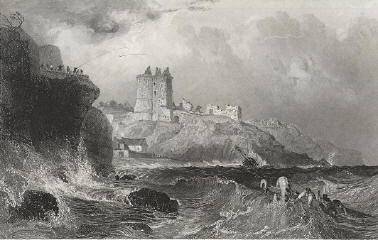|
Artist: Andrew Spratt Custodian of Dirleton Castle. These images are the copyright of Mr. Spratt who has generously given permission to display them here. For more about Andrew Spratt click here. For a complete index of Mr. Spratt's castles on this site click here. Other galleries of Mr. Spratt's work may be viewed at Clan Douglas and Clan Sinclair. Click on the castle to the left to view a larger image and scroll down to read more about the castle. Full size image of Ravenscraiq Castle |
|
|
|||
|
On a rocky 100ft cliff promontory between the Fife towns of Kirkcaldy and Dysart stands the impressive double towered royal ruin of Ravenscraig castle, planned by King James II of Scots (1437-1460) on land originally held by the Ramsay family. On three sides it was protected by the sea, while on the landward side there was a great dry ditch, now partly infilled giving a false impression of the original defenses. The name Ravenscraig appears to relate to the rock crag or craig where ravens gathered hence 'Ravens-Craig' and as a name seems to pre-date the construction of the castle. Originally the two D-plan towers, one on the east side and one to the west were linked by a machicolated battlement wall above the main entrance, which was accessed by a simple wooden bridge. What is strange about this design is the west tower is some three levels higher than the east tower, which sat level with the machicolated battlement, although two of its vaults were below the inner courtyard level. The courtyard behind the towers was enclosed by a low wall since it was protected by the sea, though an oblong tower house possibly a kitchen and storage area was perched on the far south end of the court but this may have been a later addition to the plan.
In 1470 King James III bestowed Ravenscraig to William Sinclair (St Clair),4th Earl of Orkney, in exchange for his castle in Kirkwall and "his haill right to the Earldom of Orkney." It was the Sinclairs who added the high crowstepped gabled roofs to the D-plan towers instead of completing these towers as cannon platforms which was probably King James II's original intention. During the 1650's Ravenscraig, like so many other Scottish castles suffered some damage as Oliver Cromwell's army marched north into the highlands of Scotland. By the 1800's the castle became used as a quarry and was stripped to build cottages and walls locally. August 2000AD
|

